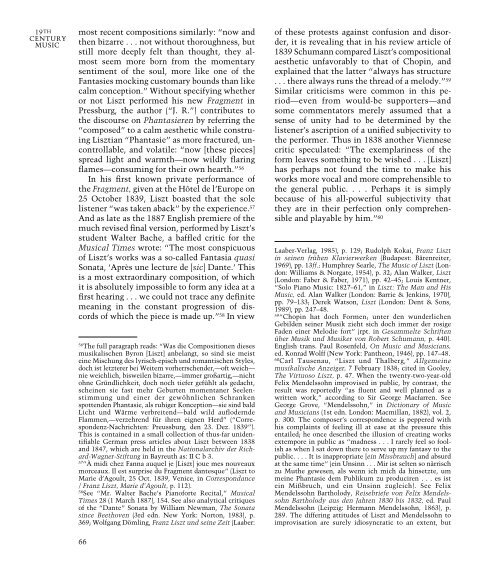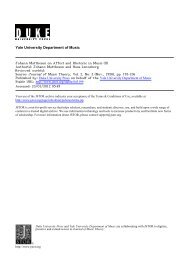Après une Lecture de Liszt: Virtuosity and ... - Free
Après une Lecture de Liszt: Virtuosity and ... - Free
Après une Lecture de Liszt: Virtuosity and ... - Free
You also want an ePaper? Increase the reach of your titles
YUMPU automatically turns print PDFs into web optimized ePapers that Google loves.
19THCENTURYMUSICmost recent compositions similarly: “now <strong>and</strong>then bizarre . . . not without thoroughness, butstill more <strong>de</strong>eply felt than thought, they almostseem more born from the momentarysentiment of the soul, more like one of theFantasies mocking customary bounds than likecalm conception.” Without specifying whetheror not <strong>Liszt</strong> performed his new Fragment inPressburg, the author (“J. R.”) contributes tothe discourse on Phantasieren by referring the“composed” to a calm aesthetic while construing<strong>Liszt</strong>ian “Phantasie” as more fractured, uncontrollable,<strong>and</strong> volatile: “now [these pieces]spread light <strong>and</strong> warmth—now wildly flaringflames—consuming for their own hearth.” 56In his first known private performance ofthe Fragment, given at the Hôtel <strong>de</strong> l’Europe on25 October 1839, <strong>Liszt</strong> boasted that the solelistener “was taken aback” by the experience. 57And as late as the 1887 English premiere of themuch revised final version, performed by <strong>Liszt</strong>’sstu<strong>de</strong>nt Walter Bache, a baffled critic for theMusical Times wrote: “The most conspicuousof <strong>Liszt</strong>’s works was a so-called Fantasia quasiSonata, ‘<strong>Après</strong> <strong>une</strong> lecture <strong>de</strong> [sic] Dante.’ Thisis a most extraordinary composition, of whichit is absolutely impossible to form any i<strong>de</strong>a at afirst hearing . . . we could not trace any <strong>de</strong>finitemeaning in the constant progression of discordsof which the piece is ma<strong>de</strong> up.” 58 In view56The full paragraph reads: “Was die Compositionen diesesmusikalischen Byron [<strong>Liszt</strong>] anbelangt, so sind sie meisteine Mischung <strong>de</strong>s lyrisch-episch und romantischen Styles,doch ist letzterer bei Weitem vorherrschen<strong>de</strong>r,—oft weich—nie weichlich, bisweilen bizarre,—immer großartig,—nichtohne Gründlichkeit, doch noch tiefer gefühlt als gedacht,scheinen sie fast mehr Geburten momentaner Seelenstimmungund einer <strong>de</strong>r gewöhnlichen Schrankenspotten<strong>de</strong>n Phantasie, als ruhiger Konception—sie sind baldLicht und Wärme verbreitend—bald wild auflo<strong>de</strong>rn<strong>de</strong>Flammen,—verzehrend für ihren eignen Herd” (“Correspon<strong>de</strong>nz-Nachrichten:Preussburg, <strong>de</strong>n 23. Dez. 1839”).This is contained in a small collection of thus-far uni<strong>de</strong>ntifiableGerman press articles about <strong>Liszt</strong> between 1838<strong>and</strong> 1847, which are held in the Nationalarchiv <strong>de</strong>r Richard-Wagner-Stiftungin Bayreuth as: II C b 3.57“À midi chez Fanna auquel je [<strong>Liszt</strong>] joue mes nouveauxmorceaux. Il est surprise du Fragment dantesque” (<strong>Liszt</strong> toMarie d’Agoult, 25 Oct. 1839, Venice, in Correspondance/ Franz <strong>Liszt</strong>, Marie d’Agoult, p. 112).58See “Mr. Walter Bache’s Pianoforte Recital,” MusicalTimes 28 (1 March 1887), 154. See also analytical critiquesof the “Dante” Sonata by William Newman, The Sonatasince Beethoven (3rd edn. New York: Norton, 1983), p.369; Wolfgang Dömling, Franz <strong>Liszt</strong> und seine Zeit (Laaber:of these protests against confusion <strong>and</strong> disor<strong>de</strong>r,it is revealing that in his review article of1839 Schumann compared <strong>Liszt</strong>’s compositionalaesthetic unfavorably to that of Chopin, an<strong>de</strong>xplained that the latter “always has structure. . . there always runs the thread of a melody.” 59Similar criticisms were common in this period—evenfrom would-be supporters—<strong>and</strong>some commentators merely assumed that asense of unity had to be <strong>de</strong>termined by thelistener’s ascription of a unified subjectivity tothe performer. Thus in 1838 another Viennesecritic speculated: “The exemplariness of theform leaves something to be wished . . . [<strong>Liszt</strong>]has perhaps not found the time to make hisworks more vocal <strong>and</strong> more comprehensible tothe general public. . . . Perhaps it is simplybecause of his all-powerful subjectivity thatthey are in their perfection only comprehensible<strong>and</strong> playable by him.” 60Laaber-Verlag, 1985), p. 129; Rudolph Kokai, Franz <strong>Liszt</strong>in seinen frühen Klavierwerken (Budapest: Bärenreiter,1969), pp. 13ff.; Humphrey Searle, The Music of <strong>Liszt</strong> (London:Williams & Norgate, 1954), p. 32; Alan Walker, <strong>Liszt</strong>(London: Faber & Faber, 1971), pp. 42–45; Louis Kentner,“Solo Piano Music: 1827–61,” in <strong>Liszt</strong>: The Man <strong>and</strong> HisMusic, ed. Alan Walker (London: Barrie & Jenkins, 1970),pp. 79–133; Derek Watson, <strong>Liszt</strong> (London: Dent & Sons,1989), pp. 247–48.59“Chopin hat doch Formen; unter <strong>de</strong>n wun<strong>de</strong>rlichenGebil<strong>de</strong>n seiner Musik zieht sich doch immer <strong>de</strong>r rosigeFa<strong>de</strong>n einer Melodie fort” (rpt. in Gesammelte Schriftenüber Musik und Musiker von Robert Schumann, p. 440).English trans. Paul Rosenfeld, On Music <strong>and</strong> Musicians,ed. Konrad Wolff (New York: Pantheon, 1946), pp. 147–48.60Carl Tausenau, “<strong>Liszt</strong> und Thalberg,” Allgemeinemusikalische Anzeiger, 7 February 1838; cited in Gooley,The Virtuoso <strong>Liszt</strong>, p. 47. When the twenty-two-year-oldFelix Men<strong>de</strong>lssohn improvised in public, by contrast, theresult was reportedly “as fluent <strong>and</strong> well planned as awritten work,” according to Sir George Macfarren. SeeGeorge Grove, “Men<strong>de</strong>lssohn,” in Dictionary of Music<strong>and</strong> Musicians (1st edn. London: Macmillan, 1882), vol. 2,p. 300. The composer’s correspon<strong>de</strong>nce is peppered withhis complaints of feeling ill at ease at the pressure thisentailed; he once <strong>de</strong>scribed the illusion of creating worksextempore in public as “madness . . . I rarely feel so foolishas when I sat down there to serve up my fantasy to thepublic. . . . It is inappropriate [ein Missbrauch] <strong>and</strong> absurdat the same time” (ein Unsinn . . . Mir ist selten so närrischzu Muthe gewesen, als wenn ich mich da hinsetzte, ummeine Phantasie <strong>de</strong>m Publikum zu produciren . . . es istein Mißbruch, und ein Unsinn zugleich). See FelixMen<strong>de</strong>lssohn Bartholody, Reisebriefe von Felix Men<strong>de</strong>lssohnBartholody aus <strong>de</strong>n Jahren 1830 bis 1832, ed. PaulMen<strong>de</strong>lssohn (Leipzig: Hermann Men<strong>de</strong>lssohn, 1863), p.289. The differing attitu<strong>de</strong>s of <strong>Liszt</strong> <strong>and</strong> Men<strong>de</strong>lssohn toimprovisation are surely idiosyncratic to an extent, but66



